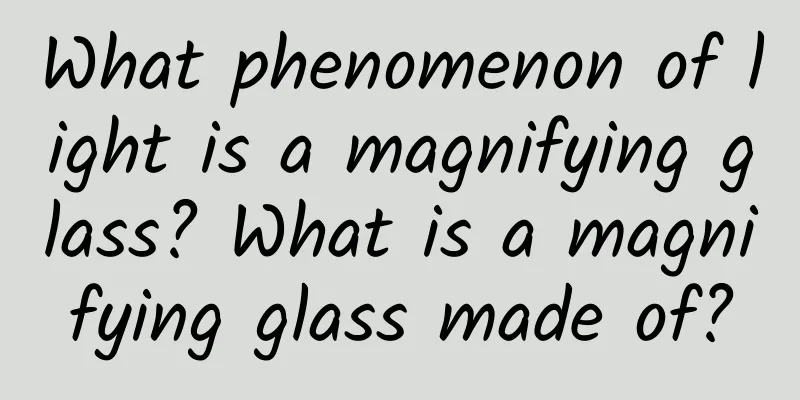What phenomenon of light is a magnifying glass? What is a magnifying glass made of?

|
The function of a magnifying glass is to magnify the visual angle. Historically, it is said that the application of a magnifying glass was proposed by a bishop in England in the 13th century, Grosseteste. Have you heard of it? In fact, even if you have learned it in textbooks, most people who don't like physics still don't know it. The following content will share with you in detail what phenomenon a magnifying glass is for light. Contents of this article 1. What phenomenon is the magnifying glass? 2. What does a magnifying glass consist of? 3. Why does a magnifying glass appear upside down when looking at something far away? 1What phenomenon is a magnifying glass?A magnifying glass is a phenomenon of light refraction. A magnifying glass is a phenomenon of light refraction when light is emitted from the air into the glass and then from the glass into the air. The light path is deflected, so it is a phenomenon of light refraction. A magnifying glass is a simple visual optical device used to observe the tiny details of an object. It is a converging lens with a focal length much smaller than the clear vision distance of the eye. When using a magnifying glass, bring it close to the eye and place the object within its focus, and the object will form a positive virtual image. In order to see tiny objects or details of objects clearly, it is necessary to move the objects closer to the eyes, which can increase the visual angle and form a larger real image on the retina. However, when the object is too close to the eye, it cannot be seen clearly. In other words, to see the smallest details clearly, not only should the object have a large enough angle to the eye, but also the appropriate distance should be taken. Obviously, for the eyes, these two requirements are mutually restricted. If a convex lens is placed in front of the eye, this problem can be solved. The convex lens is the simplest magnifying glass, which is a simple optical instrument that helps the eyes observe tiny objects or details. 2What does a magnifying glass consist of?A magnifying glass consists of two parts: the lens and the handle. 1. Lens. A whole piece of transparent or translucent object. Its refractive surface is two spherical surfaces, or one spherical surface and one flat surface. It feels very smooth and not bumpy. It is usually surrounded by materials. It is characterized by being thick in the middle and thin at the edges. 2. The handle. The handle is connected to the lens. There is no limitation on the shape. The most common one is cylindrical. The main function of a magnifying glass is to magnify the image of an object. Put the magnifying glass in front of the object at a proper distance and you can see the magnified image through the lens. Please note that the object is not actually magnified. 3Why does a magnifying glass look upside down when looking at something far away?The reason why things seen through a magnifying glass appear upside down is that parallel light rays pass through the magnifying glass (convex lens) and refraction occurs, and the distance between the object and the magnifying glass is greater than the focal length of the convex lens. In this case, an inverted image will be formed. The larger the angle of view, the larger the image, and the more details of the object can be distinguished. Moving closer to the object can increase the angle of view, but it is limited by the focusing ability of the eye. Use a magnifying glass, hold it close to the eye, and place the object within its focus to form a positive virtual image. The function of a magnifying glass is to enlarge the angle of view. Historically, it is said that the use of magnifying glasses was proposed by Grosseteste, a bishop in England in the 13th century. Beyond double the focal length, the real image is inverted and reduced; double the focal length is equal in size; From one focal length to two focal lengths, the real image is inverted and magnified; at one focal length, no image is formed; Within one focal length, the virtual image is erected and magnified; To form a real image, the object and the image are on different sides of the convex lens, and to form a virtual image, the object and the image are on the same side of the convex lens. |
>>: I heard that wearing glasses is the "culprit" for worsening myopia?
Recommend
Will my breasts swell when I get pregnant?
When you first become pregnant, you may not see a...
What are the changes in body temperature after conception?
After conception, a pregnant woman's body und...
RSP fetal position
In the later stages of pregnancy, as the baby'...
Causes of irregular uterine bleeding
When a woman's uterus shows abnormal conditio...
What is the best thing to apply when pregnant women have body odor?
If a pregnant woman has body odor in her daily li...
Can I push the engine when the automatic transmission is out of power? How can I start the automatic transmission when it is out of power? Is there any way?
We often see some drivers pushing their cars forw...
What to do if you have chills and joint pain during confinement
It is very easy for female friends to have variou...
What's wrong with my period not coming?
In recent years, more and more women have experie...
Why do women experience pain during menstruation?
Female friends must have this problem. During men...
Mashable: Data shows that 43% of parents admit to checking their children's Facebook page every day
February 18, 2013 It used to be thought that adul...
Loss of appetite during early pregnancy
As a pregnant woman, your body often goes through...
What are the benefits of squatting for women?
In fact, not only men should pay attention to the...
How to deal with vaginal candidal infection in women?
Due to the special body structure, female friends...
What are the symptoms of phlegm-damp constitution? How to regulate phlegm-damp constitution?
Phlegm-dampness constitution is one of the many c...









